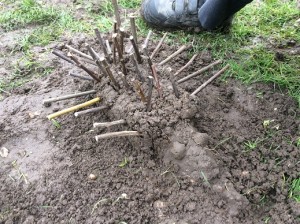
Mud, mud glorious mud! Most people see mud as something to avoid, but it offers lots of creative potential for the outdoor learning practitioner: it’s free, easy to use, safe to handle and can be found pretty much anywhere.
So, having found a nice muddy patch, how can you use it to create some artwork?
- Mud sculptures: Molehill soil is the perfect sculptural medium. Soft, crumbly and damp the soil holds and sticks together well when squashed into a ball. Small plastic fruit punnets make great moulds to make bodies for hedgehogs or giant insects. Or turn a molehill into a castle using plant pots as moulds to make towers. Embellish your sculpture with natural objects such as sticks, stones and plant materials like acorns and berries.
- Draw pictures and designs into mud: Smooth flat a patch of mud to make a canvas. Then use sticks or fingers to make patterns or pictures – add colour with colourful leaves or berries. Check out Andy Goldsworthy for amazing land art ideas.
- Tree faces: Mud mixed to the correct consistency or a lump of clay (dependant on your local geology, dig up your own clay) can be used to make characterful faces on tree trunks. Leaves, sticks and other natural materials can be used to embellish and help bring the tree to life. How old is your tree? What has it seen?

Tree face spirit
- Animal footprints: Animal tracks are often found in mud. Find a nice muddy patch that’s not too wet and practice identifying signs by making your own tracks. The heel of a hand makes a good palm pad impression and fingers for toe pads. Sticks can be used to make claw prints. Then challenge group to guess each other’s tracks.
- Mud painting: The colour of mud can vary hugely, from yellow ochres, dark umbers and rich red sienna’s – all colours which were traditionally derived from mud. To make natural earth watercolour paints: bake soil in an oven, add gum Arabic (binder) and egg (yolk and white mixed – to give the paint a lovely sheen). Thin with water. Use heavy cardstock paper.
Alternatively, for brightly coloured mud paints you’ll need: mud, liquid poster paints, a squirt of washing up liquid and water to mix. Part of the fun is experimenting!
Messy fun tips:
When creating with mud, have plenty of water nearby, mixing sticks and spades. Mud and water really go hand in hand, and only adds to the fun. Make sure old or protective clothes are worn and that hands are thoroughly washed afterwards. Disposable plastic gloves are ideal for protecting hands with cuts or hands that need a little encouragement to touch and play with mud.
